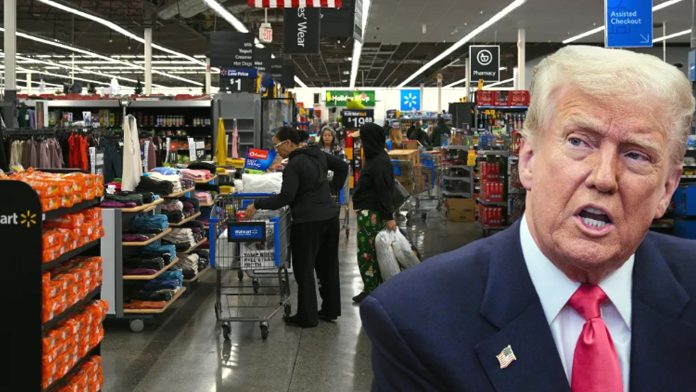After Donald Trump’s comments about Walmart’s price hike announcement, US Treasury Secretary Scott Bessent spoke with the CEO of the retail corporation about Trump’s tariffs.
Due to the higher costs from the tariffs implemented by President of the United States (POTUS) Donald Trump, retail corporation Walmart is set to raise its prices on goods. Responding to the news, Trump penned a strongly worded message addressed to Walmart, chastizing the company and warning the retailer that he will be keeping tabs on its moves.

US President Donald Trump speaking before posthumously awarding Medals of Sacrifice to three fallen Palm Beach County Sheriff’s Office deputies in Washington, D.C., on May 19, 2025. | Source: Getty Images
Walmart, long lauded for its ability to keep prices relatively low, now finds itself making a difficult pivot. The announcement to increase prices followed the release of Walmart’s first-quarter earnings, which showed a dip in profit despite steady sales.
The company earned $4.45 billion, or 56 cents per share, in the quarter ending April 30, 2025, down from $5.10 billion, or 63 cents per share, a year earlier. Adjusted earnings per share came in at 61 cents, reportedly beating analysts’ expectations of 58 cents.
The world’s largest retailer is raising prices, and it’s blaming the White House.
Walmart announced it has no choice but to increase the prices on some of its items, claiming President Trump’s trade war is upping the company’s costs: pic.twitter.com/YkRSZrpOqe
— TheStreet (@TheStreet) May 15, 2025
Revenue rose by 2.5 percent to $165.61 billion. At the opening bell on a Thursday, Walmart shares fell by 4 percent. Despite strong quarterly sales and a projected second-quarter sales growth of 3.5 to 4.5 percent, Walmart withheld a profit outlook for the quarter, citing ongoing instability in US tariff policy.
View this post on Instagram
While the company maintained its full-year guidance, issued in February, executives emphasized that the “chaotic environment” created by shifting trade regulations made near-term forecasting unreliable.
According to Walmart’s CEO Doug McMillon, price increases had already begun as early as April and accelerated further in May, particularly as the company prepared for the back-to-school retail season.

Walmart CEO Doug McMillon delivering a keynote address during the CES 2024 in Las Vegas, Nevada on January 9, 2024. | Source: Getty Images
The tariffs — especially those on Chinese imports — are beginning to erode the very foundation of Walmart’s low-cost retail model.
Though the Trump administration’s previously threatened 145 percent, import taxes were scaled back to 30 percent in a new deal announced Monday (May 12, 2025). Higher tariffs have merely been paused for 90 days, creating a temporary window of relief. Many retailers, including Walmart, are scrambling to import products such as shoes, toys, clothing, and electronics before duties spike again.
View this post on Instagram
McMillon noted that while the company sources general merchandise from dozens of countries, China remains a major supplier in specific categories like toys and tech.
Tariffs are also driving up prices on food staples like bananas, avocados, coffee, and roses due to levies on imports from Costa Rica, Colombia, and Peru. Although groceries, which account for roughly 60 percent of Walmart’s US business, have helped buffer the impact, the company is not fully insulated.
Tariffs: Walmart announced Thursday that tariffs will force the retailer to increase prices on certain items, including bananas, roses, avocados, and toys. CFO John David Rainey stated that price hikes are expected to begin by late May, with further increases in June.
Source:… pic.twitter.com/DPt6efH8aP
— Joe Kushlick (@jkushlick) May 15, 2025
In some departments, Walmart has begun absorbing costs internally, delaying price hikes to maintain consumer trust. Additionally, the retailer is working with suppliers to modify product components — for example, replacing tariff-hit aluminum with alternative materials such as fiberglass.
Consumers, meanwhile, appear to be growing more frugal amid the shifting economic terrain. Government data, released Thursday, signaled softening sales growth across the retail industry. Walmart echoed that trend, observing that customers are becoming “cautious and selective” in their purchasing behavior.
🚨 WALMART RAISING PRICES DUE TO TARIFFS
Walmart has announced it will raise prices as Trump's trade war increases costs for the company.
“We will do our best to keep our prices as low as possible but given the magnitude of the tariffs, even at the reduced levels announced this… pic.twitter.com/ATHddHr63m
— MeidasTouch (@MeidasTouch) May 15, 2025
While the company saw strong performance in groceries, health, and wellness items, sales in home goods and sporting equipment weakened. That dip was offset by increased demand in categories like automotive products, toys, and children’s apparel.
Notably, Walmart’s US comparable sales rose 4.5 percent in the second quarter — a slight slowdown from the 4.6 percent increase in the quarter prior, and the 5.3 percent growth reported in Q3 2024.
View this post on Instagram
On the digital front, Walmart’s global e-commerce sales jumped 22 percent, improving from a 16 percent gain in the previous quarter.
As one of the first major US retailers to report quarterly results, Walmart’s earnings have become a bellwether for the state of the American consumer. The earnings also present a revealing case study on how Trump’s tariff strategy is reshaping the retail landscape.
View this post on Instagram
While companies like Amazon were able to preemptively import inventory ahead of the policy rollout, Walmart is navigating these headwinds in real time, forced to balance price pressures against its long-standing promise of affordability.
President Trump wasted no time issuing a sharp rebuke to Walmart following its announcement to raise prices. Posting on Truth Social, he directly challenged the retailer’s rationale, accusing the company of using his tariff policies as a scapegoat.

Donald Trump speaking while signing legislation relating to household consumer energy policies in Washington, D.C., on May 9, 2025. | Source: Getty Images
“Walmart should STOP trying to blame Tariffs as the reason for raising prices throughout the chain,” Trump wrote. Citing the company’s strong financial performance, he added, “Walmart made BILLIONS OF DOLLARS last year, far more than expected.”
“Between Walmart and China [sic] they should, as is said, ‘EAT THE TARIFFS,’ and not charge valued customers ANYTHING,” he went on to declare.

Donald Trump speaking during an announcement on a trade deal with the United Kingdom in Washington, D.C., on May 8, 2025. | Source: Getty Images
In a warning that struck a more personal tone, he concluded, “I’ll be watching, and so will your customers!!!” The post added fuel to an already simmering economic debate, with Trump doubling down on his protectionist policies, while publicly pressuring one of the nation’s most influential retailers to absorb the costs without raising prices.

In the wake of Trump’s sharp remarks and Walmart’s price hike announcement, US Treasury Secretary Scott Bessent had a conversation with McMillon about the unfolding situation.
Speaking during an appearance on NBC’s “Meet the Press,” Bessent revealed that the call took place on Saturday (May 17) and emphasized that his intention was not to apply pressure. “Doug and I have a very good relationship,” Bessent noted, explaining that he preferred to hear directly from McMillon rather than rely on second or thirdhand reports.

During the discussion, Bessent said McMillon indicated that Walmart plans to “eat some of the tariffs,” mirroring its approach during the earlier years of the Trump administration in 2018, 2019, and 2020.
He also referenced Walmart’s recent earnings call, during which the company presented what he described as a “worst-case scenario” outlook. MarketWatch later confirmed that the call between Bessent and McMillon had been previously scheduled.
Treasury @SecScottBessent says he spoke to Walmart’s CEO after the company warned of price increases due to tariffs: “Walmart will be absorbing some of the tariffs, some may get passed on to consumers.” pic.twitter.com/FGQ4154SNT
— State of the Union (@CNNSOTU) May 18, 2025
In a statement shared with the outlet, Walmart reiterated its long-standing commitment to affordability, “We have always worked to keep our prices as low as possible and we won’t stop. We will keep prices as low as we can for as long as we can given the reality of small retail margins [sic].”
Trump’s tariffs, first announced in early April during a Rose Garden address, marked a sweeping escalation of his trade agenda.

Citing a “national economic emergency,” the president imposed a 10 percent baseline tax on imports from all nations, with significantly higher rates targeting countries that hold trade surpluses with the US. Notably, China faced a 34 percent tariff, while the European Union was hit with 20 percent.
The policy, enacted under the 1977 International Emergency Powers Act, aims to boost US manufacturing and generate hundreds of billions in revenue. But the consequences could be seismic.

Donald Trump speaking during a “Make America Wealthy Again” trade announcement event in the Rose Garden of the White House in Washington, D.C., on April 2, 2025. | Source: Getty Images
Analysts warn the tariffs could ignite global trade wars and push the average US tariff rate to levels unseen since the Great Depression. In a symbolic gesture, Trump said he had halved the proposed tariff rates to show goodwill, yet countries like Cambodia, Laos, and Madagascar still faced duties of up to 50 percent on exports to the US.
Critics, including lawmakers from both parties, have raised alarms over the potential impact on consumers, with higher prices expected on essentials such as housing, cars, and clothing.
View this post on Instagram
Still, the administration has held firm, insisting the strategy will restore fairness and reset decades of what Donald Trump believes to be economic exploitation by America’s trading partners.

